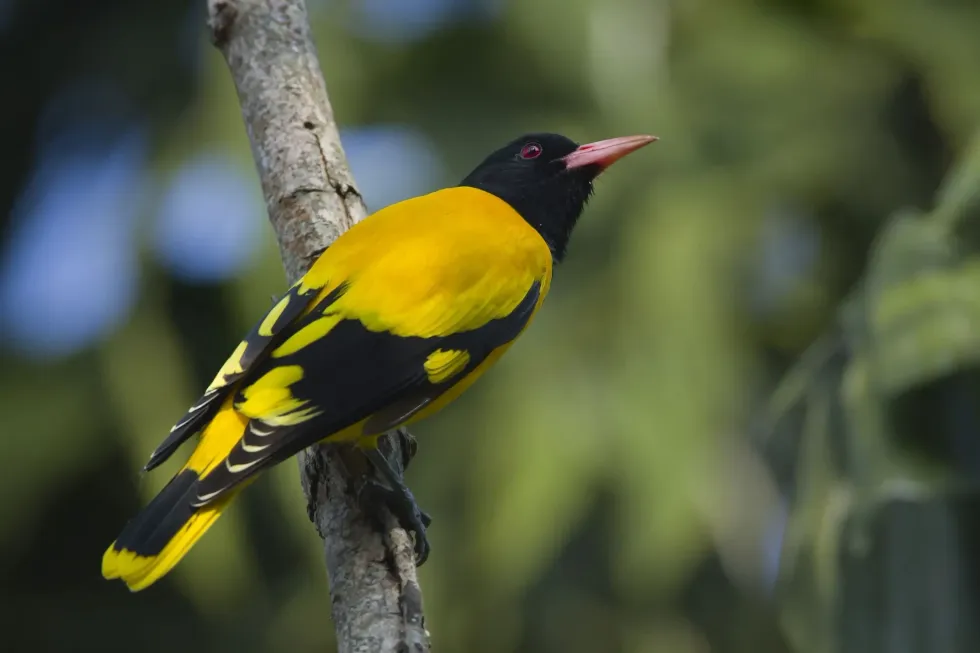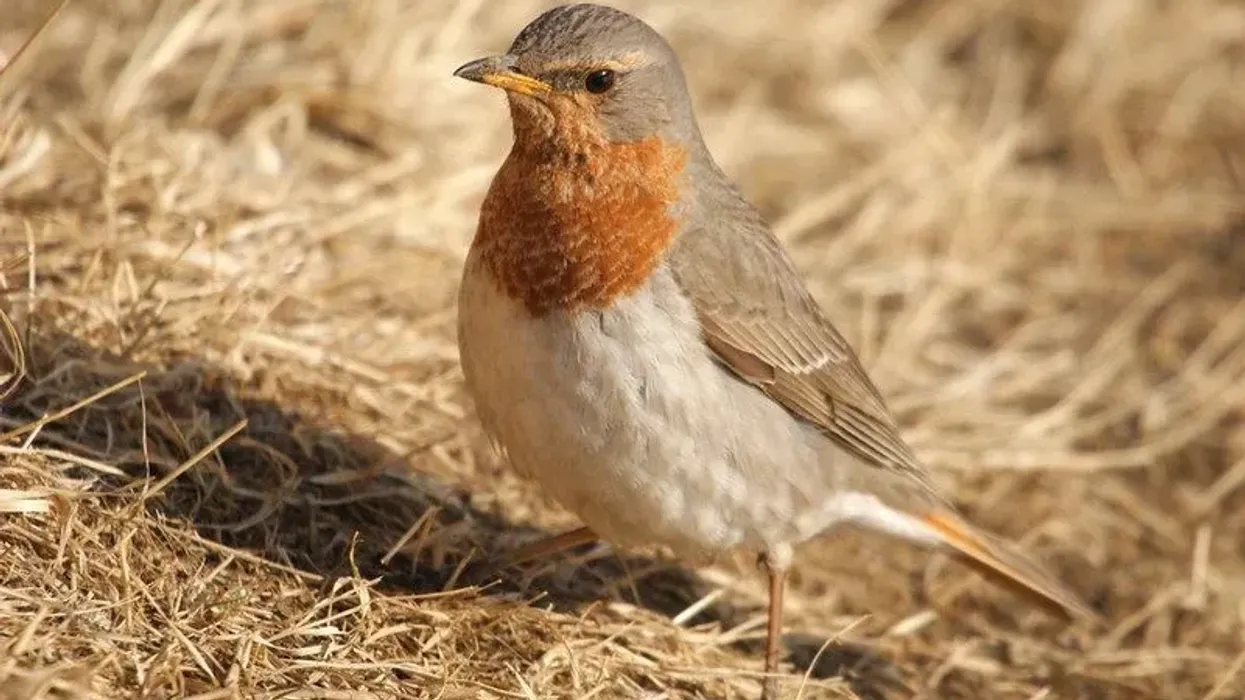Black-hooded oriole (Oriolus xanthornus) is a resident of southern Asia. It inhabits the open woodland.
They are also spotted in dry dipterocarp forests and evergreen forests. These birds feed on a variety of fruits, figs being their favorite, and also prey on small insects. Sexual dimorphism is seen in these birds.
The males are golden yellow with a black hood, whereas the female bird is a drabber with a green underpart. Orioles can be attracted in the same way as hummingbirds, by hanging out sugar water, orange slices, or jellies in the yard.
The clutch size of these birds is two to four and they can breed throughout the year with multiple broods per season. Both the male and the female birds build their nest together with leaves, grasses, vegetable fibers, and lichens.
This nest is usually suspended on high branches of the tree and contains two eggs within it. These birds are known to be in close association with people in India and Nepal.
The IUCN Red List has listed the black-hooded oriole as a species of least concern and their population is stable as of now. Keep on reading to know more fun facts about this bird.
If you liked reading this article, then do check out the black-throated gray warbler and the Myrtle warbler, here at Kidadl.
Black-hooded Oriole Interesting Facts
What type of animal is a black-hooded oriole?
The black-hooded oriole is a bird. It belongs to the family Oriolidae and genus Oriolus. The bird is a member of the phylum Chordata.
How many black-hooded orioles are there in the world?
There are more than 700,000 birds present globally, with five subspecies of the black-hooded oriole found worldwide.
Where does a black-hooded oriole live?
The black-hooded oriole (Oriolus xanthornus) is a passerine bird. Their distribution ranges from Sri Lanka and India to Indonesia. A few species of orioles are spotted in California during the winters.
What is a black-hooded oriole's habitat?
These birds belonging to the Oriolidae family inhabit evergreen forests, open woodland and cultivation areas, dry dipterocarp forests. They are also spotted in mangrove forests as well as in gardens, orchards, and other protected areas. These birds are in close association with the people of India and Nepal and therefore, are found in urban and rural areas.
Who do black-hooded orioles live with?
Black-hooded orioles are seen foraging alone or in pairs during the breeding season. They are also seen migrating in small flocks during the winters.
How long does a black-hooded oriole live?
Although the exact lifespan of the black-hooded oriole is unknown, other birds belonging to the same Oriolidae family, like the hooded oriole (Icterus cucullatus), are known to live for six to seven years in the wild.
How do they reproduce?
These birds reproduce by laying eggs. Their clutch size is about two to four.
Both male and female orioles build their nest together suspended high up on the branches of trees and containing two eggs within. These nests are built of grasses, leaves, twigs, and lichens. Orioles are known to reuse the materials of their previously built nests to build new ones.
The eggs are pinkish-white or creamy in color with brown or purple-gray spots all over. Both parents incubate their eggs. Black hood young birds are just like the adult female black-hooded oriole which is a drabber bird with a green underpart.
The black-hooded oriole breeding takes place throughout the year, with multiple broods in a season. The couples display fascinating courtship acts in flight, with males chasing females.
What is their conservation status?
The IUCN Red List has listed the black-hooded oriole of southern Asia as species of Least Concern. Their population is globally not threatened. However, increasing deforestation, illegal poaching, and pollution may impose a threat to their population.
Black-hooded Oriole Fun Facts
What do black-hooded orioles look like?
The black-hooded oriole (Oriolus xanthornus) is an attractive passerine bird with a golden yellow body. Their head is completely black with a pink pointed bill.
The tail and the wings are black in color as well. The iris is red and the legs are small and gray in color. Sexual dimorphism is seen in these birds, where the black-hooded oriole female is paler in color with a green underpart.
The tail feathers of the female are olive green with a dusky white throat. The black hood young birds are similar to adult females in appearance.
How cute are they?
These birds are extremely cute because of their bright yellow plumage that is well contrasted with a dark black head and tail. Their small body size and varied whistled calls further enhance their look and make them quite appealing.
How do they communicate?
The black-hooded oriole call bears a fluty note that appears to be somewhat nasal. The soft whistling calls are produced when they are singing, and a hoarse nasal call is produced when they are alarmed or disturbed.
How big is a black-hooded oriole?
The black-hooded oriole (Oriolus xanthornus) is about 9.1-9.8 in (23-25 cm) in length and is way bigger than the ruby-throated hummingbird, which is only about 3.5 in (8 cm).
How fast can a black-hooded oriole move?
Although the exact flying speed of these birds is not known, they are pretty quick flyers and can jump quickly from one tree to another owing to their small body size. They are also known to be agile acrobats and are seen to be hanging upside-down from high tree branches.
How much does a black-hooded oriole weigh?
These birds weigh about 0.1-0.2 lb (46-79 g).
What are the male and female names of the species?
A male bird is called a cock and a female bird is called a hen. So a male and female black hooded oriole bird species will be referred to as the same.
What would you call a baby black-hooded oriole?
A baby black-hooded oriole bird is called a chick or juvenile, just like babies of all other bird species in the world.
What do they eat?
The black-hooded oriole food includes a wide variety of fruits and seeds found in their habitat. Figs are their choice of fruit, along with different other berries. These birds are also seen to prey on small insects like moths, ants, and termites. They feed small insects to their babies with the help of their pointed bill.
Are they dangerous?
These bird species are not dangerous at all and do not impose any threat to humans.
Would they make a good pet?
The black-hooded oriole is kept as pets in houses and orchards by the people in India and Nepal. Their bright plumage and shy nature make them adorable pets.
Did you know...
The name Oriole is derived from the Latin word, aureolus, which means gold, while xanthronus is derived from the ancient Greek terms, 'xanthos' which means yellow, and 'ornis' which means bird. More than 20 names have been given to these birds, some of which include Asian black-hooded oriole, Oriental black-hooded oriole, and Indian black-hooded oriole.
What is special about black-hooded oriole?
These birds possess a solid black-colored head and throat and are often confused with the Indian golden oriole. Its striking yellow and black plumage makes it special.
Here at Kidadl, we have carefully created lots of interesting family-friendly animal facts for everyone to discover! For more relatable content, check out these shiny cowbird facts and sacred ibis facts for kids.
You can even occupy yourself at home by coloring in one of our free printable black-hooded oriole coloring pages.









